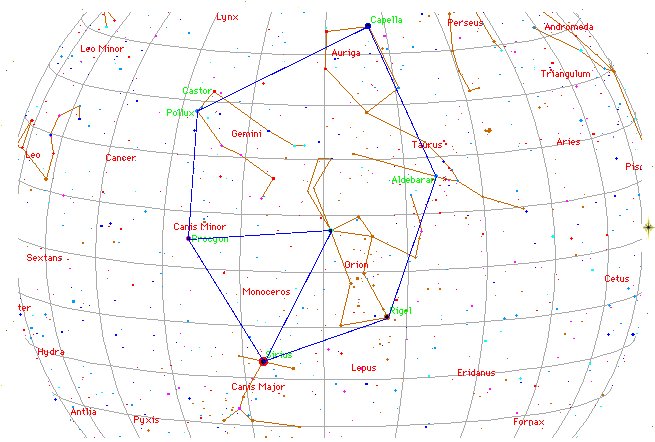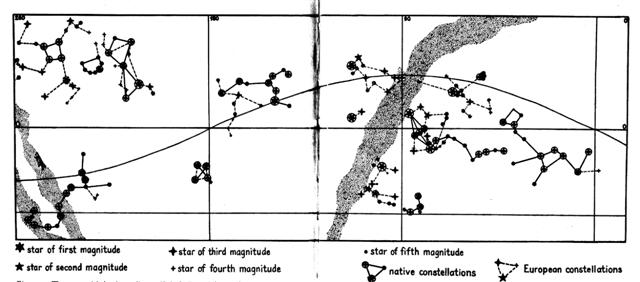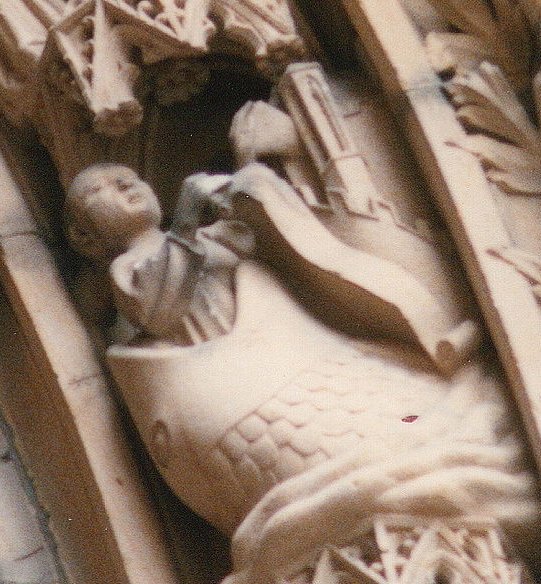438. The Club of Orion (or Hercules) was in the Milky Way River, between his Armpit and the outstretched left foot of Castor (the hairy and wet Beaver):
... Hercules first appears in legend as a pastoral sacred king and, perhaps because shepherds welcome the birth of twin lambs, is a twin himself. His characteristics and history can be deduced from a mass of legends, folk-customs and megalithic monuments. He is the rain-maker of his tribe and a sort of human thunder-storm. Legends connect him with Libya and the Atlas Mountains; he may well have originated thereabouts in Palaeolithic times. The priests of Egyptian Thebes, who called him Shu, dated his origin as '17,000 years before the reign of King Amasis'. He carries an oak-club, because the oak provides his beasts and his people with mast and because it attracts lightning more than any other tree. His symbols are the acorn; the rock-dove, which nests in oaks as well as in clefts of rocks; the mistletoe, or Loranthus; and the serpent. All these are sexual emblems. The dove was sacred to the Love-goddess of Greece and Syria; the serpent was the most ancient of phallic totem-beasts; the cupped acorn stood for the glans penis in both Greek and Latin; the mistletoe was an all-heal and its names viscus (Latin) and ixias (Greek) are connected with vis and ischus (strength) - probably because of the spermal viscosity of its berries, sperm being the vehicle of life. This Hercules is male leader of all orgiastic rites and has twelve archer companions, including his spear-armed twin, who is his tanist or deputy. He performs an annual green-wood marriage with a queen of the woods, a sort of Maid Marian. He is a mighty hunter and makes rain, when it is needed, by rattling an oak-club thunderously in a hollow oak and stirring a pool with an oak branch - alternatively, by rattling pebbles inside a sacred colocinth-gourd or, later, by rolling black meteoric stones inside a wooden chest - and so attracting thunderstorms by sympathetic magic ... And together with his left arm it evidently could have become a Sign of Jubilation (for light and life emerging once more):
Significantly the armpit (where frozen fingers can thaw out) was used twice. First for the Full Moon and then for the Sun. ... By repeating a charm, she opened the two shells and slipped inside. She could see nothing, because the sun and the moon did not then exist; and then, she could not stand up because there was not enough room in the shellfish. Constantly hunting about she at last found a snail. To endow it with power she placed it under her arm, lay down and slept for three days. Then she let it free, and still hunting about she found another snail bigger than the first one, and treated it in the same way. Then she said to the first snail: 'Can you open this room a little, so that we can sit down?' The snail said it could, and opened the shell a little.
Old-Spider then took the snail, placed it in the west of the shell, and made it into the moon. Then there was a little light, which allowed Old-Spider to see a big worm. At her request he opened the shell a little wider, and from the body of the worm flowed a salted sweat which collected in the lower half-shell and became the sea. Then he raised the upper half-shell very high, and it became the sky. Rigi, the worm, exhausted by this great effort, then died. Old-Spider then made the sun from the second snail, and placed it beside the lower half-shell, which became the earth ... We can read in the C text where this would have happened:
On the G tablet there are 242 (= 2 * 121 = 2 * 11 * 11) glyphs on side b. And side a is beginning at MARCH 21 (80), which means the corresponding place on Easter Island should be around day 80 + 184 = 264 (SEPTEMBER 21). From Punarvasu (the Doublegood Pair = Gemini) to erua maitaki (doubly good) there were *184 (Yed Prior) - *113 (Castor) = *71 precessional days. From Pollux (*116 ) to Kajam (*187) there was also *71 precessional days. From the beginning of time at Gemini to the time of rongorongo there were around 26000 * 71 / 365.25 = 5054 (= 1842 AD + 3212 BC) years. We can deduce that Castor corresponded to the Full Moon (as visualized at the navel in Ca9-17) and Pollux to the Sun. One of the Twins was mortal (Castor) because every month the face of the Full Moon demonstrated how the cycles of time moved on by first dying (†) and then rebirth (*). The perception in South America indicated how the path leading up from Rigel to Castor could have had a beginning about a quarter of a year earlier, below the Head of the Sea Beast (Cetus). In Ca1-25 we can see a separated head
Castor (*113) - *23 (Achernar, the End of the River) = *90 and Pollux (*116) - *26 (Baten Kaitos, the Belly of the Fish) = *90 (= 360 / 4). ... Heracles is swallowed by Tiamat, and disappears for three days before fighting his way out. So also, according to a Hebrew moral tale apparently based on the same icon, Jonah spent three days in the Whale's belly; and so Marduk's representative, the king of Babylon, spent a period in demise every year, during which he was supposedly fighting Tiamat ... Marduk's or Perseus's white solar horse here becomes the reward for Hesione's rescue. Heracles's loss of hair emphasizes his solar character: a shearing of the sacred king's locks when the year came to an end, typified the reduction of his magical strength, as in the story of Samson ... When he reappeared, he had no more hair than an infant ...
... Then the big Fish did
swallow him, and he had done
acts worthy of blame.
But We cast him forth on the
naked shore in a state of
sickness,
|
|||||||||||||||||||||||||||||||||||||||||||||||||||||||||||||||||||||||||||||||||||||||||||||||||||||||||||||||||||||||||||


















